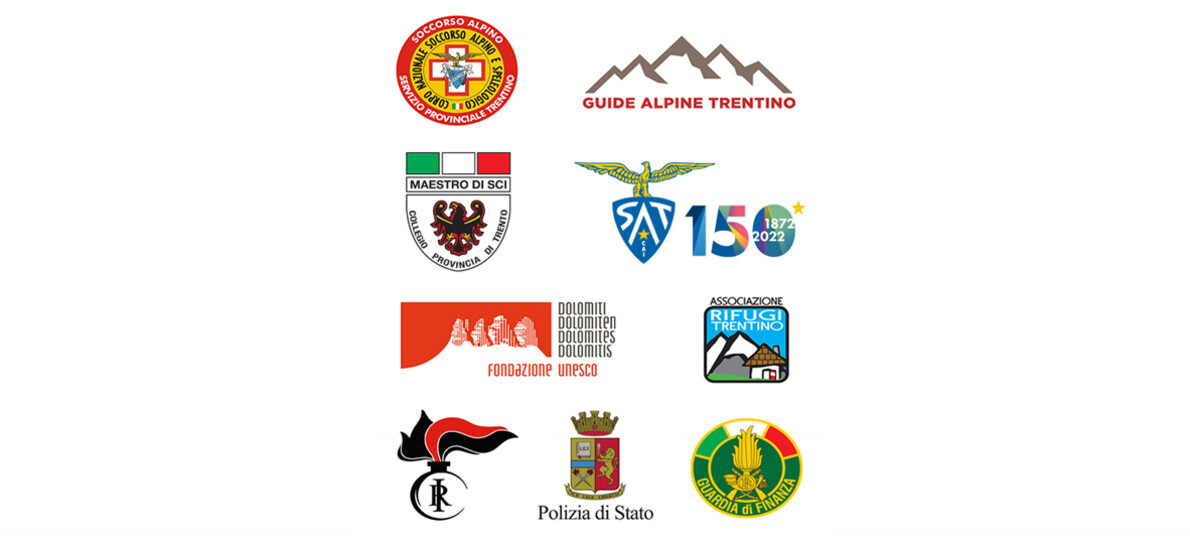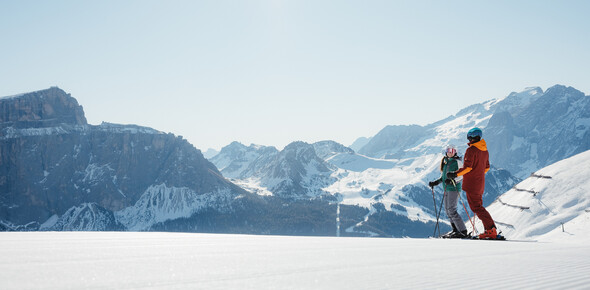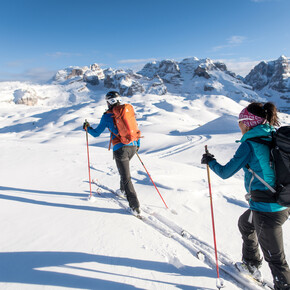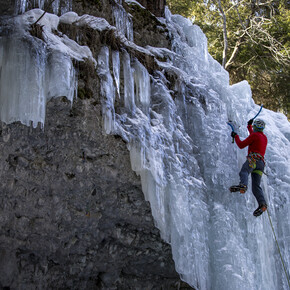Caution in the mountains in winter
Top tips from people who know and love the mountains
In the mountains, you can enjoy breathtaking experiences and a wide range of sports all year round. In winter, the choice includes on-piste skiing, ascending snowy slopes on ski mountaineering trips, hiking, snowshoeing, and ice climbing on stunning frozen waterfalls! Whatever you do, it’s essential to take a careful, sensible approach and prepare properly.
Not everyone is capable of taking part in all of these activities. You should always think carefully about whether you are fit enough and if you have the necessary skills, experience with the equipment, and knowledge of the area and the snowpack conditions. For example, did you know that the risk of avalanches depends on factors such as the steepness of the slope, external temperature, wind strength and whether there are woods or not? That’s why you should always make the most of the experience and advice of mountain guides and people who not only live and work in the mountains, but also for the mountains!
To help you remember all the right things to do in the mountains in winter, we’ve joined forces with the Trentino Mountain Hut Association, the Association of Mountain Guides, Trentino Mountain and Cave Rescue Service, the Trentino Mountaineering Club (SAT), the UNESCO Dolomites Foundation, the Trentino Provincial Association of Ski Instructors, the Autonomous Province of Trento, and Italian law enforcement agencies. Together, we’ve put together a selection of the most frequently asked questions by people like you, who love skiing and spending time in the mountains.
Before you look at the FAQs, here’s some invaluable advice that applies to all activities: always go with at least one other person and plan your activity in advance, taking into account your capabilities, the weather forecast, the nature and conditions of the route, and the risk of avalanches.
Weather and Avalanche Forecasts
Don’t just check if the weather is going to be generally good or bad. Always look at the forecasts for wind speed and direction, the temperatures at various altitudes and the probability of precipitation.
It’s important to check the weather forecast during the 48 hours before your planned activity. It is advisable to look at more than one forecast and you should seek out the ones that give detailed information specifically about the area in question. The weather reports from the previous weeks are also extremely important because they can provide an understanding of weather trends and the likelihood of any critical issues in the snowpack.
Ski mountaineers and hikers who spend time in the mountains of the Tyrol-South Tyrol-Trentino Euroregion in the winter can find all of the latest snow and weather reports at valanghe.report. The information is provided by the weather services of the three regions. It includes avalanche forecasts, with precise information about snow conditions, snow depth, air temperature and wind trends.
Make sure you examine the forecasts meticulously. Take into consideration the altitudes, the aspect and steepness of slopes, and the snowpack structure, rather than simply looking at the European Avalanche Danger Scale (1 – Low; 2 – Moderate; 3 – Considerable; 4 – High; 5 – Very High).
You should start looking at avalanche forecasts a few days before your planned activity and continue until the day prior to the activity.
Alpine Skiing
In this article we’ve put together a quick 14-point guide that sums up how to avoid accidents and have fun in the mountains!
When you’re skiing on pistes, you should have a number of “layers” of clothing: at least two and normally three. You can then put them on or take them off to suit your requirements, the temperature, the precipitation, how hard you’re working as you ski and how much you’re perspiring. A classic ski outfit consists of:
- A base layer next to your skin, covering not only your torso but also your arms and legs.
- A mid-layer (a fleece or warm jacket that’s lightweight and not too bulky).
- An outer layer that’s waterproof and protects you from the wind. It should cover your torso, arms and legs. A simple shell might be enough on warmer days, whereas you might need an insulated jacket when the weather’s colder.
Three colours are used in the piste classification system: blue, red and black. Blue is used to mark the easiest pistes, red identifies the intermediate ones and black is utilized for expert ski runs.
This marking system was developed by UNI (the Italian national standards body). The signs are circular and feature the appropriate colour for the level of difficulty of each piste.
The level of difficulty for a piste depends on two factors: the longitudinal slope and the cross slope. The steepness of pistes is shown as a percentage that indicates the ratio between the distance covered and the difference in height.
Here’s a simple example to help you to understand the classification system better: black runs (for expert skiers only) tend to have grades higher than 40% to 50%!
Lessons with a professional ski instructor are the best option for beginners who want to start skiing. It’s essential to learn how to use the equipment (skis and boots) properly, as well as the right techniques, how to recognize dangers and what precautions should be taken on pistes.
Ski Mountaineering
Ski mountaineering takes place on terrain that is not groomed, so you need to plan carefully and make sure you have the right skills and fitness levels not only to climb the slopes without overexerting yourself, but also to control your skis comfortably during the descent. In addition:
- Always try to keep your speed below 30 km/h.
- If it snows, wait at least three days before you go ski mountaineering.
- If there are not at least 10 recent descending tracks, always try to ski on slopes with a gradient lower than 30°.
- If you’re a beginner, it’s a good idea to take a course on snow science and snowpack stability. It’s also best to be accompanied by a mountain guide.
- Read forecasts, guides and other books, and call the local mountain guides or tourist information centres for advice. When you get out on the snow, the conditions might be different from what you were expecting when you were at home. They can also change during the day, forcing you to change your plans. It’s absolutely crucial to know your companions and be familiar with their fitness and skill levels. Never go ski mountaineering alone and always make sure the level of technical difficulty is appropriate for all of the members of the group!
Touring skis or a splitboard, an avalanche transceiver (which must be worn in accordance with the manufacturer’s instructions), a shovel, a probe, synthetic climbing skins, a first aid kit in your rucksack, a helmet (to wear on both ascents and descents) and a GPS device with tracking and coordinates (these are extremely useful during rescues).
PLEASE NOTE: Carrying this equipment in your rucksack isn’t enough to make you safe! You need to know how to use it if necessary and to do that you must take a special training course and get regular practice.
It is highly advisable to wear layers because over the course of the day the weather can change and so can the level of intensity of the activity. You’ll need a waterproof jacket and trousers (an outer shell), a lightweight down jacket in case it gets very cold, and a spare pair of gloves to keep in your rucksack at all times. In addition, never forget sunglasses and sun cream.
Definitely! You can find all of the information you need on the relevant section of this page.
Winter Hiking and Snowshoeing
It’s always best to follow marked trails that are properly groomed! If you really want to venture into uncontrolled environments in the heart of nature, you need to plan carefully and have the right technical skills.
If you’re a beginner, it’s a good idea to take a course on snow science and snowpack stability. It’s also best to be accompanied by a mountain guide.
Read forecasts, guides and other books, and call the local mountain guides, tourist information centres or mountain huts to ask for up-to-date information about snow conditions and which routes get followed. When you get out there, the conditions might be different from what you were expecting when you were at home. They can also change during the day, forcing you to change your plans. It’s absolutely crucial to know your companions and be familiar with their fitness and skill levels. Never go out alone and always make sure the level of technical difficulty is appropriate for all of the members of the group!
You’ll need snowshoes, crampons and trekking poles, not to mention a rucksack for carrying your sunglasses, sun cream, spare clothing and other items.
As well as your technical equipment, make sure you take avalanche safety gear: an avalanche transceiver, a shovel, a probe and a first aid kit. We strongly recommend that you take a course so that you can learn all about how to use the equipment properly and the right approach to take.
It is highly advisable to wear layers because over the course of the day the weather can change and so can the level of intensity of the activity. You’ll need winter hiking boots, a waterproof jacket and trousers (an outer shell), a lightweight down jacket in case it gets very cold, and a spare pair of gloves to keep in your rucksack at all times.
Definitely! You can find all of the information you need on the relevant section of this page.
Freeride Skiing (Off-Piste Skiing)
Off-piste skiing means going onto terrain that isn’t groomed, so you need to plan carefully and make sure you have the right skills. If you’re a beginner, it’s a good idea to take a course, find a mountain guide or ski instructor to accompany you, read forecasts, guides and other books, and call the local mountain guides, tourist information centres or ski schools for advice.
When you get out there, the conditions might be different from what you were expecting when you were at home. They can also change during the day, forcing you to change your plans. It’s absolutely crucial to know your companions and be familiar with their fitness and skill levels. Never go out alone and always make sure the level of technical difficulty is appropriate for all of the members of the group!
An avalanche transceiver (which must be worn in accordance with the manufacturer’s instructions), a helmet, a shovel, a probe, synthetic climbing skins, a first aid kit in your rucksack, and a GPS device with tracking and coordinates (these are extremely useful during rescues). You will also require skis or a snowboard with pivot bindings for short planned or unplanned climbs.
PLEASE NOTE: Simply carrying this equipment in your rucksack isn’t enough to make you safe! You need to know how to use it if necessary and to do that you must take a special training course and get regular practice.
It is highly advisable to wear layers because over the course of the day the weather can change and so can the level of intensity of the activity. You’ll need a waterproof jacket and trousers (an outer shell), a lightweight down jacket in case it gets very cold, and a spare pair of gloves to keep in your rucksack at all times. Make sure you also take sunglasses and sun cream.
Definitely! You can find all of the information you need on the relevant section of this page.
Ice Climbing
There are icefalls and frozen waterfalls of various grades that are suitable for both beginners and experts. A number of routes are available for people who have never climbed and want to learn to use crampons and ice axes. Remember that it’s always a good idea to use the services of a mountain guide, especially if you’re a beginner.
Lessons with a mountain guide are the best option for beginners who want to start ice climbing. It’s essential to learn how to use the equipment (crampons, ice axes and other climbing gear) properly, as well as the right techniques, how to recognize dangers and what precautions should be taken on icy and snowy terrain that is not groomed.
As well as the usual climbing gear (such as a helmet, harness, carabiners and rope), on ice you need special equipment such as crampons, ice axes and ice screws. In addition, you’ll be on snowy terrain so it’s important to have avalanche safety gear (an avalanche transceiver, a shovel and a probe).
The key items of clothing for this activity are crampon-compatible boots, a thermal base layer, trousers, a waterproof jacket, a headband or hat, and padded gloves. It’s also crucial to have a down jacket and a spare pair of gloves to wear if it gets very cold or your others get wet.
The ice climbing season is rather short. It’s at the coldest time of year: January, February and early March. If you want to go ice climbing later in the year, you’ll need to move up to high altitudes (more than 3000 metres above sea level), where the temperature remains low so the conditions are sufficiently safe.




